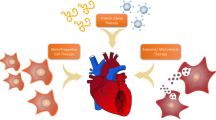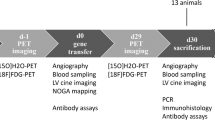Abstract
Therapeutic angiogenesis is a new potential treatment in cardiovascular disease. It is performed by the delivery of the angiogenic agents (protein, gene). Most important consideration for gene therapy is the construction of an effective therapeutic gene. Currently, VEGF is the most effective therapeutic gene for the neovascularization. We constructed the hypoxia-regulated VEGF plasmid using the Epo enhancer and RTP801 promoter. The efficiency of the pEpo-SV-VEGF and pRTP801-VEGF were evaluated by various methodsin vitro andin vivo. The results suggested that the hypoxia-inducible VEGF gene therapy system is effective and safe, which may be useful for the gene therapy of ischemic heart disease. Development of a safe and efficient gene carrier is another main requirement for successful gene therapy. Although viralbased gene delivery is currently the most effective way to transfer genes to cells, nonviral vectors are increasingly being considered forin vivo gene delivery. The advantages of nonviral gene therapy are lack of specific immunogenecity, simplicity of use, and ease of large-scale production. In addition, the simple conjugation of a targeting moiety to nonviral gene carrier can facilitate tissue-targeting gene delivery. We have developed two new gene carrier systems, TerplexDNA and WSLP (water soluble lipopolymer). These two are efficient carrier to ischemic myocardium and has low toxicity and high transfection efficiency. So it may allow for application ofin vivo gene therapy in the treatment of heart disease.
Similar content being viewed by others
References
Azrin, M. (2001) Angiogenesis, protein and gene delivery.Br. Med. Bull. 59: 211–225.
Kastrup, J., E. Jorgensen, and V. Drvota (2001) Vascular growth factor and gene therapy to induce new vessels in the ischemic myocardium. Therapeutic angiogenesis.Scand. Cardiovasc. J. 35: 291–296.
Isner, J. M. (2002) Myocardial gene therapy.Nature 415: 234–239.
Symes, J. F., D. W. Losordo, P. R. Vale, K. G. Lathi, D. D. Esakof, M. Mayskiy, and J. M. Isner (1999) Gene therapy with vascular endothelial growth factor for inoperable coronary artery disease.Ann. Thorac. Surg. 68: 836–837.
Vale, P. R., D. W. Losordo, C. E. Milliken, M. Maysky, D. D. Esakof, J. F. Symes, and J. M. Isner (2000) Left ventricular electromechanical mapping to assess efficacy of phVEGF (165) gene transfer for therapeutic angiogenesis in chronic myocardial ischemia.Circulation 102: 965–974.
Sylven, C., N. Sarkar, A. Ruck, V. Drvota, S. Y. Hassan, B. Lind, A. Nygren, Q. Kallner, P. Blomberg, J. van der Lindern, D. Lindblom, L. A. Brodin, and K. B. Islam (2001), Myocardial Doppler tissue velocity improves following myocardial gene therapy with VEGF-A165 plasmid in patients with inoperable angina pectoris.Coron. Artery Dis. 12: 239–243.
Affleck, D. G., L., Yu, D. A. Bull, S. H. Bailey, and S. W. Kim (2001) Augmentation of myocardial transfection using Terplex DNA: a novel gene delivery system.Gene Ther. 8: 349–353.
Lee, M., J. Rentz, S. Han, D. A. Bull, and S. W. Kim (2003) Water soluble lipopolymer as an efficient carrier for gene delibery to myocardium.Gene Ther. 10: 585–593.
Brogi, E., G. Schatteman, T. Wu, E. A. Kim, L. Varticovski, B. Keyt, and J. M. Isner (1996) Hypoxia-induced paracrine regulation of vascular endothelial growth factor receptor expression.J. Clin. Invest. 97: 469–476.
Lee, J. S. and A. M. Feldman (1998) Gene therapy for therapeutic myocardial angiogenesis: a promising synthesis of two emerging technologies.Nat. Med. 4: 739–742.
Springer, M. L., A. S. Chen, P. E. Kraft, M. Bednarski, and H. M. Blau (1998) VEGF gene delivery to muscle: potential role for vasculogenesis in adults.Mol. Cell 2: 549–558.
Lee, R. J., M. L. Springer, W. E. Blanco-Bose, R. Shaw, P. C. Ursell, and H. M. Blau (2000) VEGF gene delivery to myocardium: deleterious effects of unregulated expression.Circulation 102: 898–901.
Lee, M., J. Rentz, M. Bikram, S. Han, D. A. Bull, and S. W. Kim (2003) Hypoxia-inducible VEGF gene delivery to ischemic myocardium using water-soluble lipopolymer.Gene Ther. 10: 1535–1542.
Maxwell, P. H., C. W. Pugh, and P. J. Rateliffe (1993) Inducible operation of the erythropoietin 3' enhancer in multiple cell lines: evidence for a widespread oxygensensing mechanism.Proc. Natl. Acad. Sci. USA 90: 2423–2427.
Shoshani, T., A. Faerman, I. Mett, E. Zelin, T. Tenne, S. Gorodin, Y. Moshel, S. Elbaz, A. Budanov, A. Chajut, H. Kalinski, I. Kamer, A. Rozen, O. Mor, E. Keshet, D. Leshkowitz, P. Einat, R. Skaliter, and E. Feinstein (2002) Identification of a novel hypoxia-inducible factor 1-responsive gene, RTP801, involved in apoptosis.Mol. Cell. Biol. 22: 2283–2293.
Wang, G. L., B.-H. Jiang, E. A. Rue, and G. L. Semenza (1995) Hypoxia-inducible factor 1 is a basic-helix-loop-helix-PAS heterodimer regulated by cellular O2 tension.Proc. Natl. Acad. Sci. USA 92: 5510–5514.
Wenger, R. H. and M. Gassmann (1997) Oxygen(es) and the hypoxia-inducible factor-1.Biol. Chem. 378: 609–616.
Jiang, B.-H., E. Rue, G. L. Wang, R. Roe, and G. L. Semenza (1996) Dimerization, DNA binding, and transactivation properties of hypoxia-inducible factor 1.J. Biol. Chem. 271: 17771–17778.
Semenza, G. L., B. H. Jiang, S. W. Leung, R. Passantino, J. P. Concordet, P. Maire, and A. Giallongo (1996) Hypoxia response elements in the aldolase A. enolase 1, and lactate dehydrogenase A gene promoters contain essential binding sites for hypoxia-inducible factor 1.J. Biol. Chem. 271: 32529–32537.
Wang, G. L. and G. L. Semenza (1993) General involvement of hypoxia-inducible factor 1 in transcriptional response to hypoxia.Proc. Natl. Acad. Sci. USA 90: 4304–4308.
Xu, Q., Y.-S. Ji, and J. F. Schmedtje, Jr. (2000). Sp1 increases expression of cyclooxygenase-2 in hypoxic vascular endothelium. Implications for the mechanisms of aortic aneurysm and heart failure.J. Biol. Chem. 275: 24583–24589.
Lee, M., M. Bikram, S. Oh, D. A. Bull, and S. W. Kim (2004) Spl-dependent regulation of the RTP801 promoter and its application to hypoxia-inducible VEGF plasmid for ischemic disease.Pharm. Res. 21: 736–741.
Kabanov, A. V., and V. A. Kabanov (1995) DNA complexes with polycations for the delivery of genetic material into cells.Bioconjug. Chem. 6: 7–20.
Han, S., R. I. Mahato, Y. K. Sung, and S. W. Kim (2000) Development of biomaterials for gene therapy.Mol. Ther. 2: 1–16.
Wu, G. Y. and C. H. Wu (1987) Receptor-mediatedin vitro gene transformation by a soluble DNA carrier system.J. Biol. Chem. 262: 4429–4432.
Wu, G. Y. and C. H. Wu (1988) Receptor-mediated gene delivery and expressionin vivo.J. Biol. Chem. 263: 14621–14624.
Wu, C. H., J. M. Wilson, and G. Y. Wu (1989) Targeting genes: delivery and persistent expression of a foreign gene driven by mammalian regulatory elementsin vivo.J. Biol. Chem. 264: 16985–16987.
Chiou, H. C., M. V. Tangco, S. M. Levine, D. Robertson, K. Kormis, C. H. Wu, and G. Y. Wu (1994) Enhanced resistance to nuclease degradation of nucleic acids complexed to asaloglycoprotein-polylysine carrier.Nucleic Acids Res. 22: 5439–5446.
Wagner, E., M. Zenke, M. Cotten, H. Beug, and M. L. Birnstiel (1990) Transferrin-polycation conjugates as carriers for DNA uptake into cells.Proc. Natl. Acad. Sci. USA 87: 3410–3414.
Wagner, E., C. Plank, K. Zatloukal, M. Cotten, and M. L. Birnstiel (1992) Influenza virus hemagglutinin HA-2 N-terminal fusogenic peptides augment gene transfer by transferring-polylysine-DNA complexes: toward a synthetic virus-like gene-transfer vehicle.Proc. Natl. Acad. Sci. USA 89: 7934–7938.
Trubetskoy, V. S., V. P. Torchilin, S. L. Kennel, and L. Huang (1992) Use of N-terminal modified poly(L-lysine)-antibody conjugated as a carrier for targeted gene delivery in mouse lung endothelial cells.Bioconjug. Chem. 3: 323–327.
Midoux, P., C. Mendes, A. Legrand, J. Raimond, R. Mayer, M. Monsigny, and A. C. Roche (1993) Specific gene transfer mediated by lactosylated poly-L-lysine into hepatoma cells.Nucleic Acids Res. 21: 871–878.
Martinez-Fong D, J. E. Mullersman, A. F. Purchio, J. Armendariz-Borunda, and A. Martinez-Hernandez (1994) Nonenzymatic glycosylation of poly-L-lysine: a new tool for targeted gene delivery.Hepatology 20: 1602–1608.
Erbacher, P., M. T. Bousser, J. Raimond, M. Monsigny, P. Midoux, and A. C. Roche (1996) Gene transfer by DNA/glycosylated polylysine complexes into human blood monocyte-derived macrophages.Hum. Gene Ther. 7: 721–729.
Choi, Y. H., F. Liu, J. S. Choi, S. W. Kim, and J. S. Park (1999) Characterization of a targeted gene carrier, lactose-polyethylene glycol-grafted ploy-L-lysine and its complex with plasmid DNA.Hum. Gene Ther. 10: 2657–2665.
Kim, J.-S., A. Maruyama, T. Akaike, and S. W. Kim (1997).In vitro gene expression on smooth muscle cells using a terplex delivery system.J. Control. Release 47: 51–59.
Kim, J.-S., B. I. Kim, A. Maruyama, T. Akaike, and S. W. Kim (1998) A new non-viral DNA delivery vector: the terplex system.J. Control. Release 53: 175–182.
Kim, J.-S., A. Maruyama, T. Akaike, and S. W. Kim (1998) Terplex DNA delivery system as a gene carrier.Pharm. Res. 15: 116–121.
Yu, L., M. Nielsen, S. Han, and S. W. Kim (2001) Terplex DNA gene carrier system targeting artery wall cells.J. Control. Release 72: 179–189.
Havel, R. J. (1998) Receptor and non-receptor mediated uptake of chylomicron remnants by the liver.Atherosclerosis 141 Suppl 1: S1-S7.
Shih, I. L., R. S. Lees, M. Y. Chang, and A. M. Lees (1990) Focal accumulation of an apolipoprotein B-based synthetic oligopeptide in the healing rabbit arterial wall.Proc. Natl. Acad. Sci. USA 87: 1436–1440.
Lougheed, M., E. D. Moore, D. R. Scriven, and U. P. Steinbrecher (1999) Uptake of oxidized LDL by macrophages differs form that of acetyl LDL and leads to expansion of an acidic endolysosomal compartment.Arterioscler. Thromb. Vasc. Biol. 19: 1881–1890.
Abdallah, B., A. Hassan, C. Benoist, D. Goula, J. P. Behr, and B. A. Demeneix (1996) A powerful nonviral vector forin vivo gene transfer into the adult mammalian brain: polyethylenimine.Hum. Gene Ther. 7: 1947–1954.
Godbey, W. T., K. K. Wu, and A. G. Mikos (1999) Size matters: molecular weight affects the efficiency of poly(ethylenimine) as a gene delivery vehicle.J. Biomed. Mater. Res. 45: 268–275.
Benns, J. M., A. Maheshwari, D. Y. Furgeson, R. I. Mahato, and S. W. Kim (2001) Folate-PEG-folate-graftpolyehylenimine-based gene delivery.J. Drug Target 9: 123–139.
Han, S., R. I. Mahato, and S. W. Kim (2001) Watersoluble lipopolymer for gene delivery.Bioconjug. Chem. 12: 337–345.
Author information
Authors and Affiliations
Corresponding author
Rights and permissions
About this article
Cite this article
Choi, D. Polymer based cardiovascular gene therapy. Biotechnol. Bioprocess Eng. 12, 39–42 (2007). https://doi.org/10.1007/BF02931801
Received:
Accepted:
Issue Date:
DOI: https://doi.org/10.1007/BF02931801




